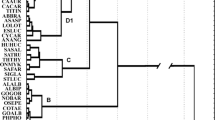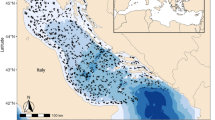Abstract
Predictive models in invasion biology rely on knowledge of the life history and ecological role of invading species. However, species may change in key traits as they invade a new region, making prediction difficult. For marine invertebrate invaders there have been too few comparative studies to determine whether change in key traits is the exception or the rule. Here we examined populations of the intertidal barnacle Chthamalus proteus in three locations in its native range in the Caribbean and Atlantic, and in the Hawaiian Islands, where it has recently invaded, as a model system for such comparative studies. We measured body size, fecundity, population density and vertical distribution, compared habitat use and investigated aspects of the barnacle’s ecological role in Curaçao, Panama and Brazil and the main Hawaiian Islands. In terms of these measures, the barnacle has undergone little change in its invasion of Hawaii. Thus, if this barnacle had been studied in its native range, predictions about its spread in Hawaii could have been made. As little was known about this barnacle in either its native range or Hawaii, we also carried out studies of its larval life history, fecundity, growth, and mortality. Based on this work, we predict that this barnacle will continue to spread, aided by vessel traffic, throughout the Hawaiian Islands and elsewhere in the Pacific.





Similar content being viewed by others
References
Andow DA, Kareiva PM, Levin SA, Okubo A (1990) Spread of invading organisms. Landsc Ecol 4(2–3):177–188
Blaustein AR, Kuris AM, Alio JJ (1983) Pest and parasite species-richness problems. Am Nat 122:556–566
Blossey B, Notzold R (1995) Evolution of increased competitive ability in invasive nonindigenous plants: a hypothesis. J Ecol 83:887–889
Carroll SP, Dingle H (1996) The biology of post-invasion events. Biol Conserv 78:207–14
Coles SL, DeFelice RC, Eldredge LG, Carlton JT (1999) Historical and recent introductions of non-indigenous marine species into Pearl Harbor, Oahu, Hawaiian Islands. Mar Biol 135:147–158
Crooks J (1999) Scale-dependent effects of an introduced, habitat-modifying mussel in an urbanized wetland. First national conference on marine bioinvasions. Massachusetts Institute of Technology, Cambridge, MA
Cubit JD (1990) Global warming and oil spills could cool shoaling reefs. Ocean sciences meetings (joint meetings of the American Geophysical Union and American Society of Limnology and Oceanography), New Orleans, LA, p 104
Daehler CC, Carino DA (2000) Predicting invasive plants: prospects for a general screening system based on current regional models. Biol Invas 2:93–102
Dando PR, Southward AJ (1980) A new species of Chthamalus (Crustacea: Cirripedia) characterized by enzyme electrophoresis and shell morphology: with a revision of other species of Chthamalus from the Western Shores of the Atlantic Ocean. J Mar Biol Assoc UK 60:787–831
Edmondson CH (1946) Reef and shore fauna of Hawaii. Bernice P. Bishop Museum, Honolulu, p 381
Edmondson CH, Ingram WM (1939) Fouling organisms in Hawaii. Occas Pap Bernice P. Bishop Mus 14:251–300
Elton CS (1958) The ecology of invasions by animals and plants. Methuen & Co. Ltd., London, p 181
Firing E (1996) Currents observed north of Oahu during the first five years of HOT. Deep Sea Res Part II Top Stud Oceanogr 43(2–3):281–303
Fukui Y (1995) Seasonal changes in testicular structure of the sea anemone Haliplanella lineata (Coelenterata: Actinaria). Invertebrate Reproduction and Development 27(3):197–204
Gordon JA (1970) An annotated checklist of Hawaiian barnacles (Class Crustacea, Subclass Cirripedia) with notes on their nomenclature, habitats and Hawaiian localities. University of Hawaii, Hawaii Institute of Marine Biology, p 130
Griffiths CL, Hockey PAR, Van Erkom Schurink C, Le Roux PJ (1992) Marine invasive aliens on South African shores: implications for community structure and trophic functioning. S Afr J Mar Sci 12:713–722
Grosholz ED (1996) Contrasting rates of spread for introduced species in terrestrial and marine systems. Ecology 77(6):1680–1686
Grosholz ED, Ruiz GM (1996) Predicting the impact of introduced marine species: multiple lessons from the multiple invasions of the European green crab Carcinus maenas. Biol Conserv 78:59–66
Grosholz ED, Ruiz GM (2003) Biological invasions drive size increases in marine and estuarine invasions. Ecol Lett 6:700–705
Higgins SI, Richardson DM (1996) A review of models of alien plant spread. Ecol Modell 87:249–265
Kado R (2003) Invasion of Japanese shores by the NE Pacific barnacle Balanus glandula and its ecological and biogeographical impact. Mar Ecol Prog Ser 249:199–206
Kay EA (1979) Hawaiian marine shells. Bishop Museum Press Honolulu p 653
Lohrer AM, Whitlach RB, Wada K, Fukui Y (2000) Home and away: comparisons of resource utilization by a marine species in native and invaded habitats. Biol Invas 2:41–57
Matsuda C (1973) A shoreline survey of free-living intertidal barnacles (Class Crustacea; Subclass Cirripedia; Order Thoracica) on the island of Oahu, Hawaii. Master’s thesis, Zoology Department, University of Hawaii, Honolulu, 60 pp
Neto J (2003) Estrutura da comunidade de peixes recifais das ilhas do Pai, da Mãe e da Menina na região de Itaipu, Niterói. Master’s thesis, Biologia Marinha, Universidade Federal Fluninense, Rio de Janeiro, 57 pp
Nyberg CD, Wallentinus I (2005) Can species traits be used to predict marine macroalgal introductions? Biol Invas 7(2):265–279
Parnell PE (2000) The effects of circulation, larval planktonic period, adult distribution and pollution on benthic recruitment in Hawaiian coastal waters. PhD dissertation, Oceanography Department, University of Hawaii, Honolulu, 274 pp
Pheloung PC, Williams PA, Halloy SR (1999) A weed risk assessment model for use as a biosecurity tool evaluating plant introductions. J Environ Manage 57:239–251
Pilsbry HA (1928) Littoral barnacles of the Hawaiian Islands and Japan. Proc Acad Nat Sci Philadelphia 79:305–334
Pitombo FB (2004) Phylogenetic analysis of the Balanidae (Cirripedia, Balanomorpha). Zool Scr 33(3):261–276
Raybould AF, Gray AJ, Lawrence MJ, Marshall DF (1991) The evolution of Spartina anglica C.E. Hubbard (Gramineae): origin and genetic variability. Biol J Linn Soc 43:111–126
Reichard SH, Hamilton CB (1997) Predicting invasions of woody plants introduced into North America. Conserv Biol 11(1):193–203
Smallwood KS, Salmon TP (1992) A rating system for potential exotic birds and mammal pests. Biol Conserv 62(3):149–159
Southward AJ (1975) Intertidal and shallow water cirripedia of the Caribbean. Studies on the fauna of Curacao and other Caribbean islands 150(46):1–53
Southward AJ, Burton RS, Coles SL, Dando PR, DeFelice R, Hoover J, Parnell PE, Yamaguchi T, Newman WA (1998) Invasion of Hawaiian shores by an Atlantic barnacle. Mar Ecol Prog Ser 165:119–126
Southward AJ, Newman JA (1977) Aspects of the ecology and biogeography of the intertidal and shallow-water balanomorph cirripedia of the Caribbean and adjacent sea-areas. FAO Fisheries Report, Rome, No. 200, pp 407–425
Stiling P, Simberloff D (2000) The frequently and strength of nontarget effects of invertebrate biological control agents of plant pests and weeds. In: Follet PA, Duan JJ (eds) Nontarget effects of biological control. Kluwer Academic Publishers, Boston, pp 31–43
Strathmann MF (1987) Reproduction and development of marine invertebrates of the northern Pacific Coast. Data and methods for the study of eggs, embryos, and larvae. University of Washington Press, Seattle, pp 670
Suarez AV, Tsutsui ND, Holway DA, Case TJ (1999) Behavioral and genetic differentiation between native and introduced populations of the Argentine ant. Biol Invas 1:43–53
Torchin ME, Lafferty KD, Dobson AP, McKenzie VJ, Kuris AM (2003) Introduced species and their missing parasites. Nature 421:628–630
Tucker KC, Richardson DM (1995) An expert system for screening potentially invasive alien plants in South African fynbos. J Environ Manage 44:309–338
Vallarino EA, Elias R (1997) The dynamics of an introduced Balanus glandula population in the Southwestern Atlantic rocky shores. The consequences on the intertidal community. Mar Ecol 18(4):319–355
Williamson M (1996) Biological invasions. Chapman & Hall, London
Young PS (1993) The Verrucomorpha and Chthamaloidea from the Brazilian coast (Crustacea: Cirripedia). Rev Bras Biol 53(2):255–267
Young PS (1995) New interpretations of South American patterns of barnacle distribution. In: Schran F, Høeg J (eds) New frontiers in barnacle evolution, Crustacean Issues 10. AA Balkema, Rotterdam, pp 229–253
Zardus J, Hadfield M (2005) Multiple origins and incursions of the Atlantic barnacle Chthamalus proteus in the Pacific. Mol Ecol 14: 3719–3733
Acknowledgements
Funding for this study was provided by the Edmondson Research Fund, and the Ecology, Evolution and Conservation Biology program at the University of Hawaii and an NSF graduate research fellowship (to CJZ); a grant from the Hawaii Conservation Alliance (to MGH and JDZ); and a National Science Foundation Undergraduate Mentoring in Environmental Biology internship (to VF). This study was also funded in part by a grant from the National Oceanic and Atmospheric Administration, Project #R/AN-1, which is sponsored by the University of Hawaii Sea Grant College Program, SOEST, under Institutional Grant No. NA86RG0041 from NOAA Office of Sea Grant, Department of Commerce (to MGH). The views expressed herein are those of the authors and do not necessarily reflect those of NOAA or any of its subagencies. UNIHI-SEAGRANT-JC-00-34. We thank the Smithsonian Tropical Research Station, for hosting CJZ at the Galeta Marine Laboratory and CARMABI for hosting her in Curaçao. Field assistance was provided by: Inez Campbell in Panama, Elroy Cocheret de la Moriniere in Curaçao, and Andrew Altieri, Kim del Carmen, Anuschka Faucci, Blu Forman, Julie Goldzman, Brian Nedved, Stacy Pang and Allan Parsa in Hawaii. L. Scott Godwin, Steve L. Coles, and Lucius Eldredge from the Bernice P. Bishop Museum generously shared data with us. Drs. Alan Southward and Bill Newman assisted us with species identifications, and we thank them also for helpful discussions about C. proteus.
Author information
Authors and Affiliations
Corresponding author
Rights and permissions
About this article
Cite this article
Zabin, C.J., Zardus, J., Pitombo, F.B. et al. A tale of three seas: consistency of natural history traits in a Caribbean–Atlantic barnacle introduced to Hawaii. Biol Invasions 9, 523–544 (2007). https://doi.org/10.1007/s10530-006-9056-y
Received:
Accepted:
Published:
Issue Date:
DOI: https://doi.org/10.1007/s10530-006-9056-y




